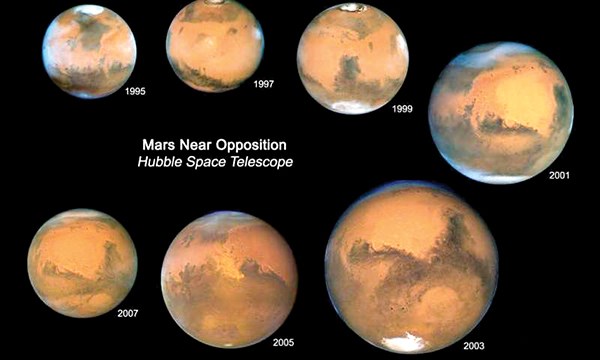This summer has been pretty interesting with Comet NEOWISE, the Perseids and some close lunar/planetary appulses in September. (Yes, it’s my new vocabulary word of the month.) October, however, is all about Mars – but the COVID-19 threat we’re facing limits our options somewhat.
Opposition occurs when Earth passes between the sun and a celestial object – they’re opposite to each other in the sky. Because of our orbital periods – 365 days for Earth and 780 earth days for Mars – a Mars opposition happens about every 26 months. However, the accompanying composite of Hubble images from previous oppositions illustrates that there’s more to it than just that. For example, although opposition is Oct. 13, we’re actually slightly closer on Oct. 6.
First, neither planet has a circular orbit; Earth’s is slightly elliptical and Mars’ is much more so. Hence, the close approach distance varies according to how close or far from the Sun each planet is. Second, Earth and Mars orbit in slightly different planes; Mars can be above or below the plane of Earth’s orbit and therefore a bit further away. As well, Mercury and Venus slightly affect Earth’s orbit and Jupiter affects everything, so all the orbits change slowly over time. Finally, we’re in the northern hemisphere; a near-winter opposition puts Mars much higher in the sky at night and we look through much less atmosphere. Although Mars isn’t quite as close as it was in July 2018, it will be about 30 degrees higher – better seeing.
The Astronomy Picture of the Day site (APOD) at https://apod.nasa.gov/apod/ for Sept. 11 has a striking photo of Mars emerging from behind the Moon taken on Sept. 6 from Brazil, one of five occultations this year. The photo, lovely as it is, illustrates the problem of viewing Mars for most of us: you need a telescope. While you can see Jupiter as a small disc and four moons with good binoculars and a tripod, Mars at its best is only a third that size. Without the current pandemic, I’m sure the Sechelt observatory would be open to the public for this opposition and people could stare to their hearts’ content, but at this point it doesn’t look good. Any changes will be posted on the club website.
As in September, Jupiter and Saturn are low in the south after sunset, after their opposition in late July. The New Moon on the 16th coincides with its perigee (large tides) and it will pass Jupiter and Saturn a week later on the 22nd and 23rd. Interestingly, it will be a Full Moon on the 1st AND the 31st.
Remember, all of the movements of moon and planets described can be checked out on the web at: www.heavens-above.com. The next regular meeting of the Astronomy Club should be Oct. 9 at 7 p.m. using Zoom. Information on the speaker and topic and how to register for the meeting will be on the club website at https://sunshinecoastastronomy.wordpress.com/ the week of the meeting.
– Richard Corbet



